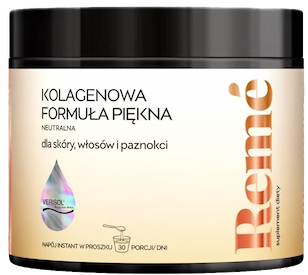Golfers' elbow: symptoms, treatment, exercises. How do you recognise it?
Golfer's elbow is a painful condition that can be treated effectively. Find out how.


Learn more about our editorial process
.

Learn more about our editorial process
.

Learn more about our editorial process
.

Learn more about our editorial process
.
Why you can trust us
Articles on Natu.Care are written based on scientific research, data from government websites and other reliable sources. The texts are written in cooperation with doctors, nutritionists and other health and beauty experts. Articles are reviewed before publication and during significant updates.
.Learn more about our editorial process
.Information about advertisements
Content on Natu.Care may contain links to products from the sale of which we may receive a commission. When creating content, we adhere to high editorial standards and take care to be objective about the products discussed. The presence of affiliate links is not dictated by our partners, and we select the products we review ourselves completely independently.
.Learn more about our terms and Conditions
.Even if Tiger Woods is not your idol, you can develop golfer's elbow. And you'll find out soon enough, because the ailment is quite painful.
You could say that golfer's elbow is such a rare twin brother of tennis elbow. Both conditions are tendinopathies, i.e. lesions of the tendons, which may be accompanied by inflammation during exacerbations. However, there are several characteristic differences between the two.
From this article you will learn:
- What golfer's elbow is. .
- What its causes and symptoms are. .
- How to differentiate between golfer's elbow and tennis elbow. .
- What treatment methods are most effective. .

Sprawdź, jak może on zadbać o zdrowie Twoich stawów i urodę! Kolagen Premium (10 000 mg) wiśnia
Natu.Care Kolagen Premium Sport 10000 mg, wiśnia
Natu.Care Kolagen Premium dla zdrowia stawów, skóry, paznokci i włosów. Wołowy kolagen w optymalnej dawce 10 000 mg. Przebadany przez niezależne laboratorium.
Sprawdź cenę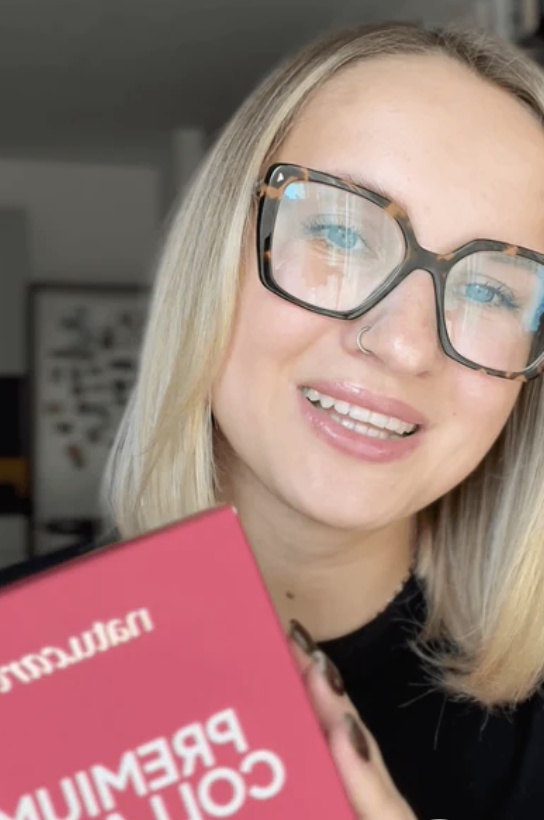
Ten kolagen dobrze się rozpuszcza, super smakuje – jak taki soczek wiśniowy. Moje włosy przestały wypadać, są gęstsze i zdrowsze a cera promienna.@Dominika P.
See also:
.
- tennis elbow
- Best collagen for tennis elbow
- Best collagen for tendons
- Best collagen for joints
- Best collagen for bones
- Collagen for athletes
- Collagen for runners
- Grandmother's ways for joints
What is golfer's elbow?
.
Golfer's elbow, sometimes also called baseballer's elbow is enthesopathy of the medial epicondyle of the humerus. The condition involves degradation of collagen fibres at the attachment site of the muscles responsible for wrist movement to the humerus (specifically the medial epicondyle)and.
In golfer's elbow it is characteristic that the lesions (and therefore the pain) involve the wrist flexor muscles running on the inside of the forearm .
.
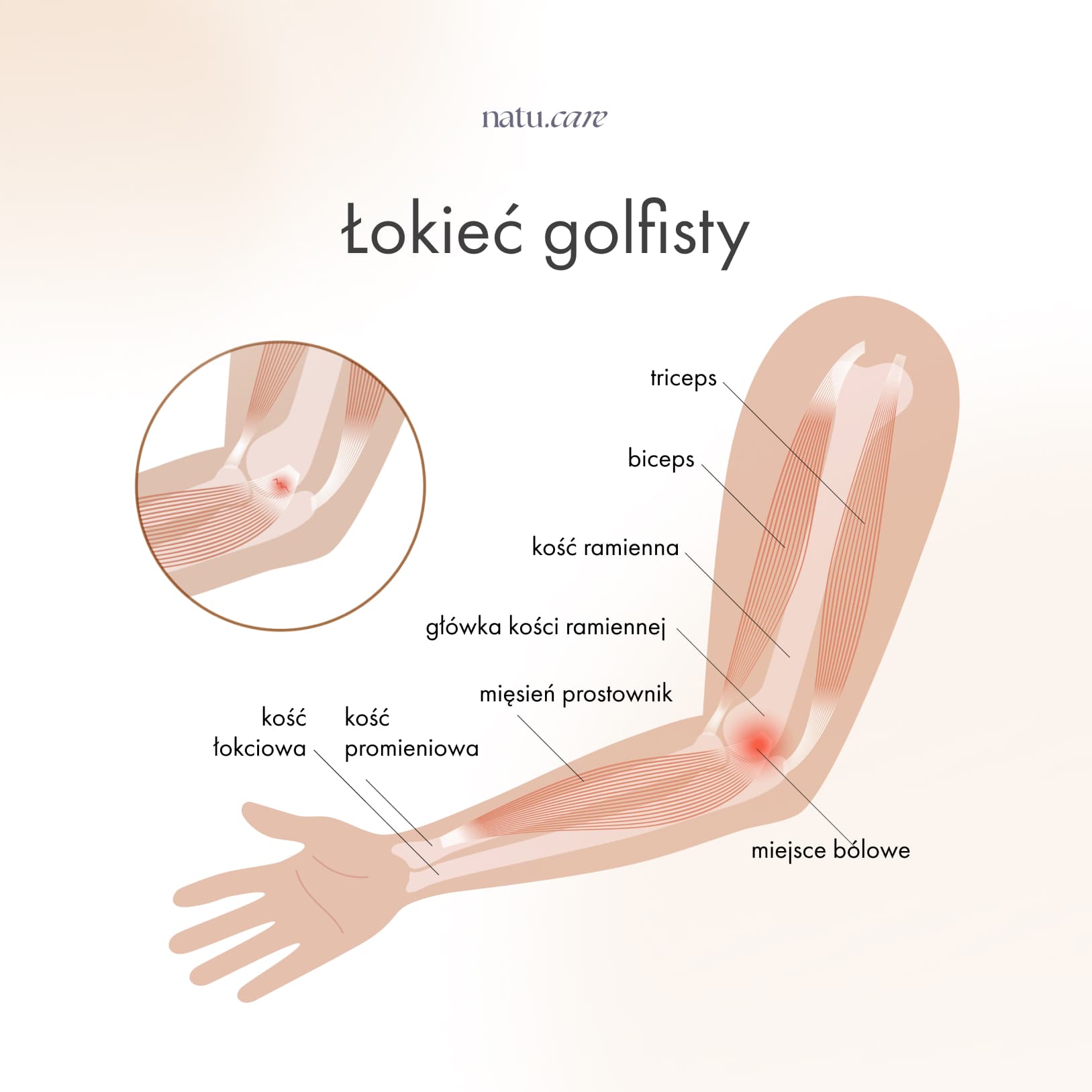
In the affected area, chronic inflammation can form and blood vessels and nerve tissue can proliferate, causing additional tenderness and pain in the elbow .
Causes of golfer's elbow
.
The cause of golfer's elbow is prolonged exposure to monotonous, rotational movements of the wrist and forearm, such as when driving screws or hitting with a golf club. However, according to research, 90% of cases of this ailment do not affect athletes at alland.
In fact, this ailment often affects people who play golf, baseball, squash, badminton or tennis - especially those who have not yet mastered correct hitting technique.
.
But overloading the wrist flexor muscle attachments can also happen to fitters, mechanics, dentists, carpenters and even... office workers. That's right - sitting at a desk can also result in a real sports injury. That's why it's worth taking care ergonomics of your working environment in advance.
What you can do to take care of your body at office work:
.
- .
- Most office chairs are height and back tilt adjustable. Adjust them so that when you sit, your elbows rest against the desk bent at 90° and your shoulders are loosely lowered.
- Consider using a chair with a backrest.
- Consider using special silicone wrist pads, especially if you do a lot of typing. .
- Experts also recommend the use of vertical computer mice, which allow you to maintain a more natural wrist position. .
- Figure out and take breaks. It may sound rather strange and certainly wouldn't appeal to your primary school teacher, but experts say that staying in one position for long periods of time is the worst thing you can do for your spine and entire musculoskeletal system. You don't have to sit upright as a string for eight hours. Just change your body position frequently.
There are also circumstances conducive to golfer's elbow. Risk of medial epicondyle enthesopathy increases in peopleand:
- youth, .
- smokers, .
- suffering from diabetes, .
Symptoms of golfer's elbow
.
The symptoms of golfer's elbow are pain and tenderness on the inside of the elbow joint radiating along the entire forearm, up to the wrist and even the 4th and 5th fingers of the hand. In addition, there may be stiffness of the joint, swelling, weakness of grip strength and tingling and numbness of the handand.
Pain leads to reduced mobility of the affected limb, as well as emerging inflammation, which exacerbates all symptoms.
.
Pain most often occurs with activities that require rotation of the wrist and forearm with additional resistance. It sounds quite complicated, but these will include, for example:
- shaking hands to greet someone, .
- lifting shopping nets, .
- washing windows or mirrors, .
In the first stage of development of golfer's elbow, pain may only occur at the beginning of movement. Later, as the condition progresses, it may accompany you throughout the activityand.
Golfer's elbow versus tennis elbow
.
Both conditions are very similar to each other. From a medical perspective, they differ in that golfer's elbow involves the muscle attachment pronators of the wrist, while tennis elbow involves the muscle attachment pronators of the wristand.
What does this mean for you? It is that with golfer's elbow there is pain on the internal side of the elbow, and with tennis elbow on the external side. It is also worth mentioning that golfer's elbow is a much rarer ailmentand.
See how the two conditions differand:
. . .
|
Conditions . |
Golfer's elbow |
tennis elbow . |
||
|
Place affected |
Wrist flexor muscle attachment |
Wrist flexor muscle attachment . |
Carpal extensor muscle attachment |
Wrist extensor muscle attachment |
|
Carpal extensor muscle attachment |
||||
|
Location of pain |
Pain on the inside of the elbow |
Pain on the outside of the elbow |
||
|
Prevalence |
About 0.4% |
Even 40% |
||
|
Most vulnerable age group |
45-64 years old - more often women than men |
. |
35-54 years old |
Golfer's elbow test
.
To diagnose golfer's elbow, you need to visit an orthopaedist. Only a doctor is able to make a clear and certain diagnosis and recommend effective treatment. It is worth remembering that there are many diseases that can give very similar symptoms and only a specialist will be able to refer you to the appropriate tests to confirm or rule them out.
The basic tests for golfer's elbow performed by an orthopaedic surgeon during a manual examination are the reverse Cozen test and the golfer's elbow symptom testand.
.
To perform the golfer's elbow symptom test:
- .
- Stand in a relaxed position. The specialist will grasp your elbow so that his/her fingers are at the level of the medial epicondyle of the humerus.
- Take the elbow.
- Bend your arm at the elbow and perform a rotation so that the inside of your hand faces the ceiling. .
- The specialist will now drive your fingers downwards, causing a dorsal wrist flexion. .
- While keeping your hand in this position, the specialist will straighten your hand at the elbow joint. .
The reverse Cozen test is very similar to the above, except that you start with your arm straight and the specialist will bend it at the elbow joint, keeping the wrist in dorsiflexion. The reverse Cozen test is most likely to be performed, as a natural follow-up to the golfer's elbow symptom test.
Both tests will come out positive if you feel a stabbing pain on the inside of your elbow when straightening or bending your arm.
Medical practitioner Kacper Nihalani talks about another method, the Polk test, which helps distinguish between tennis elbow and golfer's elbow:
"The patient picks up any object weighing 2-3kg. He sits down with it and flexes his elbow slightly. He performs pronation with the hand holding the object (pronation is the movement of turning the hand with the back of the hand upwards). He then bends his elbow to raise his arm. During this action, the arm remains motionless.
If the patient feels pain on the outside of the elbow when flexing the arm, this suggests the pathology of tennis elbow.
When golfer's elbow is suspected, the patient takes an object in the same way and sits down. This time he or she flexes the elbow, but the hand is in a supinated position (the movement of turning the palm of the hand upwards). If the soreness is on the inner side - we are dealing with golfer's elbow pathology".
.
Treatment of golfer's elbow
.
Treatment of golfer's elbow includes the use of painkillers and anti-inflammatory drugs and a break from the activity that led to the condition. The muscle attachments can also be relieved by using elbow orthoses and stabilisers. Cryotherapy, shockwave and iontophoresis treatments, as well as appropriate exercises, are also helpful.
.
The primary and most important treatment for golfer's elbow is to stop doing the activity that caused the enthesopathyand. If it was sports training, be sure to discontinue it for the time indicated by your doctor. If it was caused by your work, a specialist may issue you with a medical leave of absence so that the muscle attachments have time to regenerate and rest.
Bead ointments and medicines
.
Golfer's elbow ointments and oral medications have analgesic and anti-inflammatory effects. They will help you relieve the symptoms of the condition and make daily life easier, but they do not cure the conditionand.
Effective treatment should target the causes, not just mask bothersome symptoms. Keep this in mind when ingesting your next pain pill. Ointments and oral medications for golfer's elbow should be used as an adjunct, not as the only remedy.
Interesting facts
Cold compresses can also provide pain relief - especially if the pain has worsened after exerciseand.
What else can work to help?
.
The role of collagen in the functioning of the musculoskeletal system has long been known. For muscle attachments (i.e. tendons), the most important are collagen type I and type III. Supplementation of the youth protein can help you regenerate your elbow joint and reduce its stiffness.
Natu.Care Collagen Premium 5000 mg, mango-maracuja

- Collagen content: 5000 mg marine collagen hydrolysate
- .
- Additional active ingredients: vitamin C, low molecular weight hyaluronic acid (and L-theanine and coenzyme Q10 in cocoa flavoured collagen or vitamin A and vitamin E in mango–passion fruit flavoured collagen)
- .
- Form: powder sachets
- .
- Dose: 1 sachet per day
- .
- Sufficient for: 30 days
- .
Product description
Fish collagen from the Natu.Care brand in a dose of 5000 mg. The formula contains a sufficient portion of the active substance to positively affect your joints, musculoskeletal system and immunity.
Take care of your tendons, joint cartilage, ligaments, muscles and even bones by supplying them with the building blocks to function properly. Move without bólu and provide the necessary support for any physical activity.
And as a „gratis” to regular supplementation, you will also receive firm skinóhand, healthy and shiny hair and strong nails.
Natu.Care Premium Collagen is available in two flavours – Cacao Bloom and Rise&Shine. Both formulas are based on the following active ingredients: marine collagen hydrolysate, wild roseóbud extract and hyaluronic acid.
Additionally, Cacao Bloom contains natural L-theanine, coenzyme Q10 and defatted Dutch cacao. Rise&Shine instead contains vitamin E and vitamin A.
These are the best collagens in the world.
These best fish collagens on the market also rós taste – Cacao Bloom is a treat for chocolate lovers. Rise&Shine will appeal to those whoóenjoy the refreshing taste of mangoófruit and passion fruit.
Pros and cons
Fish collagen from the Natu.Care brand in a dose of 5000 mg. The formula contains a sufficient portion of the active substance to positively affect your joints, musculoskeletal system and immunity.
Take care of your tendons, joint cartilage, ligaments, muscles and even bones by supplying them with the building blocks to function properly. Move without bólu and provide the necessary support for any physical activity.
And as a „gratis” to regular supplementation, you will also receive firm skinóhand, healthy and shiny hair and strong nails.
Natu.Care Premium Collagen is available in two flavours – Cacao Bloom and Rise&Shine. Both formulas are based on the following active ingredients: marine collagen hydrolysate, wild roseóbud extract and hyaluronic acid.
Additionally, Cacao Bloom contains natural L-theanine, coenzyme Q10 and defatted Dutch cacao. Rise&Shine instead contains vitamin E and vitamin A.
These are the best collagens in the world.
These best fish collagens on the market also rós taste – Cacao Bloom is a treat for chocolate lovers. Rise&Shine will appeal to those whoóenjoy the refreshing taste of mangoófruit and passion fruit.
Additional information
Fish collagen from the Natu.Care brand in a dose of 5000 mg. The formula contains a sufficient portion of the active substance to positively affect your joints, musculoskeletal system and immunity.
Take care of your tendons, joint cartilage, ligaments, muscles and even bones by supplying them with the building blocks to function properly. Move without bólu and provide the necessary support for any physical activity.
And as a „gratis” to regular supplementation, you will also receive firm skinóhand, healthy and shiny hair and strong nails.
Natu.Care Premium Collagen is available in two flavours – Cacao Bloom and Rise&Shine. Both formulas are based on the following active ingredients: marine collagen hydrolysate, wild roseóbud extract and hyaluronic acid.
Additionally, Cacao Bloom contains natural L-theanine, coenzyme Q10 and defatted Dutch cacao. Rise&Shine instead contains vitamin E and vitamin A.
These are the best collagens in the world.
These best fish collagens on the market also rós taste – Cacao Bloom is a treat for chocolate lovers. Rise&Shine will appeal to those whoóenjoy the refreshing taste of mangoófruit and passion fruit.
User review
Fish collagen from the Natu.Care brand in a dose of 5000 mg. The formula contains a sufficient portion of the active substance to positively affect your joints, musculoskeletal system and immunity.
Take care of your tendons, joint cartilage, ligaments, muscles and even bones by supplying them with the building blocks to function properly. Move without bólu and provide the necessary support for any physical activity.
And as a „gratis” to regular supplementation, you will also receive firm skinóhand, healthy and shiny hair and strong nails.
Natu.Care Premium Collagen is available in two flavours – Cacao Bloom and Rise&Shine. Both formulas are based on the following active ingredients: marine collagen hydrolysate, wild roseóbud extract and hyaluronic acid.
Additionally, Cacao Bloom contains natural L-theanine, coenzyme Q10 and defatted Dutch cacao. Rise&Shine instead contains vitamin E and vitamin A.
These are the best collagens in the world.
These best fish collagens on the market also rós taste – Cacao Bloom is a treat for chocolate lovers. Rise&Shine will appeal to those whoóenjoy the refreshing taste of mangoófruit and passion fruit.
Natu.Care Collagen Premium 10000 mg, cherry
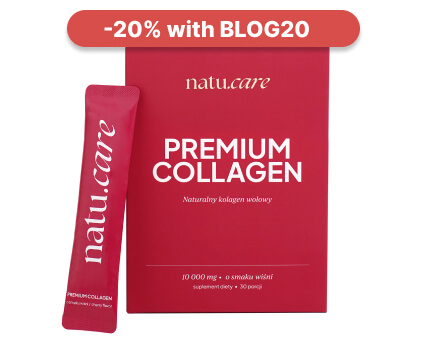
- Collagen content: 10,000 mg of hydrolyzed bovine collagen
- Additional active ingredients: vitamin C, low molecular weight hyaluronic acid, glucosamine, chondroitin, extract of Indian frankincense resin (boswellia serrata)
- Form: powder sachets for drinking
- Serving: 1 sachet per day
- Lasts for: 30 days
Product description
One of the strongest collagens on the market, providing as much as 10,000 mg per daily serving. This product can effectively support the condition of joints, skin, hair, and nails.
With this supplement, you will support your skeletal and joint system as well as your beauty, helping you visually halt the aging process and feel rejuvenated!
Pros and cons
Pros:
- The daily portion of collagen is very large – as much as 10,000 mg.
- Proven collagen formula – COLLinstant, whose effectiveness has been confirmed in clinical studies.
- Effective dose of hyaluronic acid, which additionally moisturizes the skin and positively affects joint health.
- Vitamin C supports the body's natural collagen production.
- Glucosamine is a fundamental building block of compounds found in joint cartilage and a component of collagen that gives elasticity to connective tissue in tendons.
- Chondroitin is a natural component found in the human body, mainly in cartilage. This large molecule (mucopolysaccharide) has the ability to absorb water, which helps maintain the elasticity and resilience of cartilage.
- Frankincense resin extract supports blood circulation and joint mobility and reduces their stiffness. It may help alleviate inflammatory conditions.
- The composition has been tested by the independent and accredited J.S. Hamilton laboratory.
Cons:
- None.
Additional information
Users praise Natu.Care Collagen Premium for the easy dissolving of the powder.
ALLDEYNN Collarose Fish
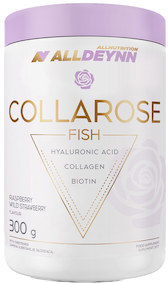
- Collagen content: 5000 mg hydrolysate fish collagen VERISOL F® .
- Additional active ingredients: vitamin C, hyaluronic acid, biotin
- Form: powder to dissolve in water .
- Dose: one scoop (6 g) of powder daily .
- Sufficient for: 50 days .
Product description
Atlantic cod collagen VERISOL F® contained in the formula are easily absorbed collagen peptides of fish origin. Regular supplementation can firm your skinóhand and slow down the ageing process. Your nails will become stronger and stop breaking. The addition of biotin will improve the condition of your hairów. The collagen portion is high enough to also have a good effect on your joints, muscles and bones.
Pros and cons
Atlantic cod collagen VERISOL F® contained in the formula are easily absorbed collagen peptides of fish origin. Regular supplementation can firm your skinóhand and slow down the ageing process. Your nails will become stronger and stop breaking. The addition of biotin will improve the condition of your hairów. The collagen portion is high enough to also have a good effect on your joints, muscles and bones.
Additional information
Atlantic cod collagen VERISOL F® contained in the formula are easily absorbed collagen peptides of fish origin. Regular supplementation can firm your skinóhand and slow down the ageing process. Your nails will become stronger and stop breaking. The addition of biotin will improve the condition of your hairów. The collagen portion is high enough to also have a good effect on your joints, muscles and bones.
Expert and user opinion
Atlantic cod collagen VERISOL F® contained in the formula are easily absorbed collagen peptides of fish origin. Regular supplementation can firm your skinóhand and slow down the ageing process. Your nails will become stronger and stop breaking. The addition of biotin will improve the condition of your hairów. The collagen portion is high enough to also have a good effect on your joints, muscles and bones.
DuoLife Collagen fish collagen 2500 mg

- Collagen content: 2500 mg collagen
- Additional active ingredients: vitamin C, silicon, glucosamine, hyaluronic acid, nettle and bamboo extracts
- Form: liquid to drink .
- Dose:25 ml .
- Sufficient for: 30 days .
Product description
100% natural collagen liquid without unnecessary ingredientsós. The composition of ingredientsós improves the appearance and condition of skinóry, hairów, nails. DuoLife is a good choiceór if you notice the first signs of skinóry ageing or want to stop this process. A tasty liquid, convenient to use.
Pros and cons
100% natural collagen liquid without unnecessary ingredientsós. The composition of ingredientsós improves the appearance and condition of skinóry, hairów, nails. DuoLife is a good choiceór if you notice the first signs of skinóry ageing or want to stop this process. A tasty liquid, convenient to use.
Additional information
100% natural collagen liquid without unnecessary ingredientsós. The composition of ingredientsós improves the appearance and condition of skinóry, hairów, nails. DuoLife is a good choiceór if you notice the first signs of skinóry ageing or want to stop this process. A tasty liquid, convenient to use.
User review
100% natural collagen liquid without unnecessary ingredientsós. The composition of ingredientsós improves the appearance and condition of skinóry, hairów, nails. DuoLife is a good choiceór if you notice the first signs of skinóry ageing or want to stop this process. A tasty liquid, convenient to use.
Pharmovit liquid collagen 10000 mg
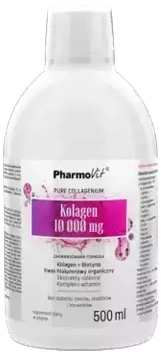
- Collagen content: 10000 mg hydrolysed bovine collagen types I and III .
- Additional active ingredients: hyaluronic acid, natural plant extracts, vitamin C, B vitamins, zinc, vitamin D
- Form: vials .
- Dose: 25 ml .
- Sufficient for: 20 days .
Product description
A solid daily dose of collagen for jointómuscle and bone health and beauty. The duo of collagen and vitamin C has a positive effect on each other, so that „the protein of youth” is better absorbed and more efficiently produced in the body.
Pros and cons
A solid daily dose of collagen for jointómuscle and bone health and beauty. The duo of collagen and vitamin C has a positive effect on each other, so that „the protein of youth” is better absorbed and more efficiently produced in the body.
Additional information
A solid daily dose of collagen for jointómuscle and bone health and beauty. The duo of collagen and vitamin C has a positive effect on each other, so that „the protein of youth” is better absorbed and more efficiently produced in the body.
KFD Premium Collagen+
Product description
High dose of collagen and a real bomb of vitamins C and D and organic sulphur. With this preparation the effects will come immediately. You will improve the firmness of your skin and reduce wrinkles. Your hair and nails will be strong and shiny.
A generous dose of collagen will improve the mobility of your jointsós, benefit your bone system and muscles. Do you do sports and need a product thatós able to keep up with your needs? This product will do the trick.
Pros and cons
High dose of collagen and a real bomb of vitamins C and D and organic sulphur. With this preparation the effects will come immediately. You will improve the firmness of your skin and reduce wrinkles. Your hair and nails will be strong and shiny.
A generous dose of collagen will improve the mobility of your jointsós, benefit your bone system and muscles. Do you do sports and need a product thatós able to keep up with your needs? This product will do the trick.
Additional information
High dose of collagen and a real bomb of vitamins C and D and organic sulphur. With this preparation the effects will come immediately. You will improve the firmness of your skin and reduce wrinkles. Your hair and nails will be strong and shiny.
A generous dose of collagen will improve the mobility of your jointsós, benefit your bone system and muscles. Do you do sports and need a product thatós able to keep up with your needs? This product will do the trick.
Expert opinion
High dose of collagen and a real bomb of vitamins C and D and organic sulphur. With this preparation the effects will come immediately. You will improve the firmness of your skin and reduce wrinkles. Your hair and nails will be strong and shiny.
A generous dose of collagen will improve the mobility of your jointsós, benefit your bone system and muscles. Do you do sports and need a product thatós able to keep up with your needs? This product will do the trick.
Product description
The dietary supplement from Remé contains beef collagen in a patented formula and vitamin C, whichóra aids its absorption. The formula comes in three flavours: neutral, orange-maracuja and strawberry-pomegranate. The formula can effectively support and improve the condition of the skinóry, hairóry and nails.
Pros and cons
The dietary supplement from Remé contains beef collagen in a patented formula and vitamin C, whichóra aids its absorption. The formula comes in three flavours: neutral, orange-maracuja and strawberry-pomegranate. The formula can effectively support and improve the condition of the skinóry, hairóry and nails.
Additional information
The dietary supplement from Remé contains beef collagen in a patented formula and vitamin C, whichóra aids its absorption. The formula comes in three flavours: neutral, orange-maracuja and strawberry-pomegranate. The formula can effectively support and improve the condition of the skinóry, hairóry and nails.
The dietary supplement from Remé contains beef collagen in a patented formula and vitamin C, whichóra aids its absorption. The formula comes in three flavours: neutral, orange-maracuja and strawberry-pomegranate. The formula can effectively support and improve the condition of the skinóry, hairóry and nails.
Stabilisers, bands and orthoses
.
Suitable stabilisers for the elbow joint are designed to relieve pressure on the wrist flexor muscle attachments, which both facilitates healing and can reduce pain.
It is important to choose bands specifically designed to support the elbow joint in golfer's elbow, i.e. thin orthoses that only cover the top of the forearm, rather than sleeves that stabilise the entire elbow joint (these will be of no use here).
.
Such bands can also be used preventively (prophylactically) - for example, if your occupation increases the risk of contracting this condition, or you have already suffered from golfer's elbow in the past and want to avoid a recurrence.
Taping for golfer's elbow
.
Kinesiotaping, known as taping for short, involves applying special tapes along the muscle fibres when they are stretched to their maximum. This reduces muscle tension, which can bring pain relief.
However, unlike orthoses, taping for tennis elbow will not relieve muscle strain and will not cure the ailment. However, it can be used successfully as an adjunctive technique.
Physiotherapy
.
Physiotherapy is currently one of the most effective treatments for golfer's elbow. Its scope encompasses both a well-chosen programme of exercises and rehabilitation treatments. According to research, the best results are obtained with a combination of exercises performed by the patient and treatment methodsand.
.
The success of physiotherapy largely depends on the correct execution of the exercises prescribed by the physiotherapist also at home. This helps to consolidate the results of the sessions with the physiotherapist..
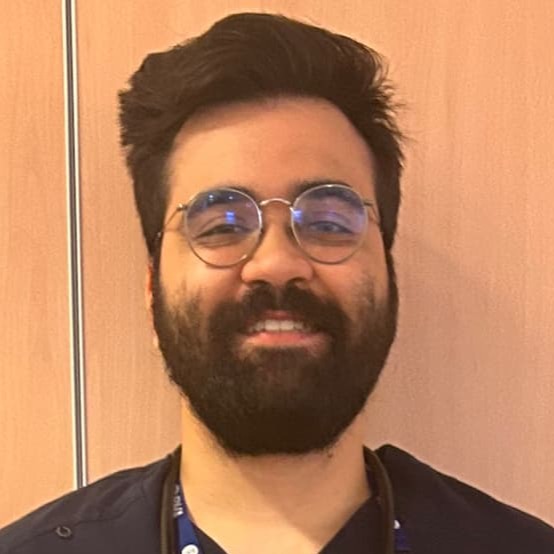 .
.
Kacper Nihalani doctor
.
The most effective treatments for golfer's elbow areand:
- dry needling, .
- shockwave, .
- electrical stimulation, .
- ionophoresis, .
- phonophoresis, .
- manipulative techniques (massage), .
Exercises for golfer's elbow
.
The simple exercises outlined below are recommended by specialists for both the treatment and prevention of golfer's elbow. Remember, however, that if you suffer from enthesopathy of the medial epicondyle of the humerus, a physiotherapist will select an individual exercise programme for you.
These are 5 simple exercises for golfer's elbow:
.
- Squeeze ball. Sit in a comfortable position and position your arm so that it is bent at the elbow at a 90° angle. Take a soft ball the size of a tennis ball and crush it in your hand, stopping when your fingers are clenched on it. Then slowly loosen the grip. Do 2-3 series of 10-15 repetitions. .
- Wrist muscle stretch. Extend your straight arm out in front of you. With your other hand, point the fingers of your palm upwards so that your wrist bends. Press gently on your fingers, making sure your elbow joint remains straight - until you feel a slight pull on your muscles. Hold this position for about 20 seconds. Perform 5 repetitions. .
- Automassage. Sit so that your arm is bent at the elbow at a 90° angle. With your other hand, grasp your forearm from underneath just at the elbow. Try to locate the most painful area with your thumb. Press lightly on it and make lateral movements for 3-5 minutes. .
- Rolling. If you have a roller (preferably a flat roller without tabs), you can roll the wrist muscles with it for a few minutes. Run the roller along the muscles - from the wrist to the elbow and back again. Try to make sure that the pressure of the roller is equal along the entire length of the muscles. .
- Exercises with weights. You will need a weight for this - start with the lightest one (0.5kg) and then gradually increase the load. Sit at a table so that your arm is bent at a right angle and your wrist is behind the edge of the tabletop. Grasp the weight with an underhand grip - the inside of your hand should be facing upwards. Slowly and actively (using your muscles, not gravity) lower the weight downwards. With the help of your other hand, pull it back up. The exercise is to concentrate only on lowering the weight. .
What are the risks of untreated golfer's elbow?
.
Untreated golfer's elbow can lead to permanent changes in the tendon structure of the wrist flexor muscle attachment and degradation of the joint surfaces. In extreme cases, this can lead to a reduction or loss of function in the affected hand. The pain will worsen and make daily functioning increasingly difficultand.
See also:
.
- Knee pain - causes and treatment .
- Home remedies for sore knees
- Knee crunching and shooting
- Gonarthrosis
- Compaction

Sprawdź, za co pokochały go tysiące klientek Natu.Care Premium Omega-3ᵀᴳ -15% z kodem BLOG15
Natu.Care Omega-3ᵀᴳ Premium
Natu.Care Omega-3ᵀᴳ Premium dla zdrowia serca, mózgu i odporności. Najlepsza przyswajalność. Optymalna dawka 750 mg. Przebadana przez niezależne laboratorium.
Zobacz więcej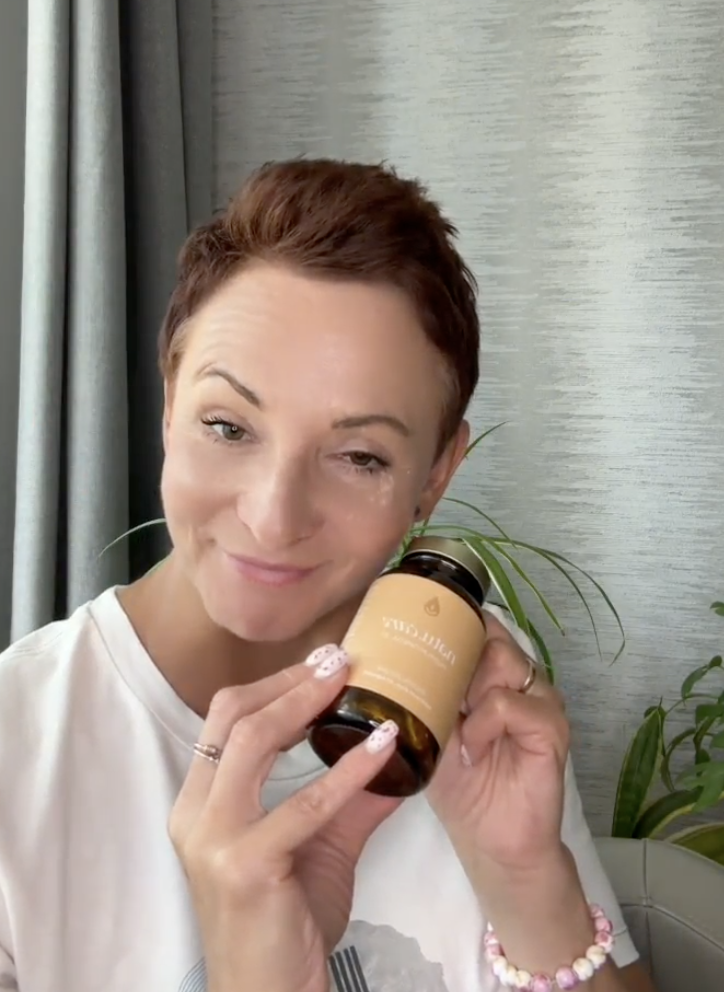
Produkt ma super skład, transparentną etykietę i co dla mnie jest ważne – małe kapsułki do połknięcia. Nie ma też nieprzyjemnego efektu odbijania rybą, który miałam spożywając inne produkty. Widzę znaczną poprawę odporności. Polecam!@Kasia P.
Summary
.
- Golfer's elbow is an ailment of the attachment of the flexor muscles of the wrist to the medial epicondyle of the humerus.
- Golfer's elbow manifests as pain located on the inside of the elbow joint. .
- Athletes (especially golfers, baseball players, badminton and tennis players) and people whose work requires prolonged rotational movements of the wrist and forearm (fitters, dentists, but also office workers) are at risk of this condition. .
- The basis for the cessation of the ailment is the cessation of the activities that lead to it. It is recommended to stop sports training or to reduce its frequency and load. In the case of occupational work, sick leave can be used.
- The following is recommended.
- The most effective treatments for golfer's elbow are exercise and physiotherapy treatments and the use of suitable orthoses. Medicines and painkilling and anti-inflammatory ointments, as well as taping, can also be used as an auxiliary treatment.
FAQ
.How to put a brace on a golfer's elbow:
.Apply the golfer's elbow brace according to the following steps:
.- Begin by identifying the painful area on the elbow. The brace should be positioned directly below this point.
- Follow these steps.
- Open the bandage and place the top of the bandage on the forearm, approximately 2-3 cm below the painful area.
- Wrap the bandage around the painful area.
- While wrapping the brace around your forearm, make sure it is snug but not too tight. It should exert moderate pressure but not cause pain or impede blood circulation. .
- Fasten the brace using hooks or Velcro. .
The golfer's elbow brace works by relieving pressure on sore muscles and tendons to help relieve pain and promote healing. You can comfortably wear it throughout the day. This is especially important for people who put strain on their elbow during sport or work.
Where does golfer's elbow hurt?
.Golfer's elbow pain is located on the inside of the elbow joint, near a section of the arm bone called the medial epicondyle. This area is the attachment point for many of the muscles of the forearm that control the movements of the hand. The pain is the result of strain on these muscles and tendons, often caused by repetitive rotational movements of the hand.
How can you tell if I have tennis elbow or golfer's elbow?
.The easiest way to distinguish between these conditions is to identify where the pain is. If you feel pain on the outside of your elbow joint, you are most likely suffering from tennis elbow. Golfers' elbow, on the other hand, causes pain on the inside of the elbow. In both cases, the pain can radiate along the entire forearm up to the wrist and even the fingers.
Do not diagnose on your own, however, but go to an orthopaedist. Only a doctor is able to make a definitive diagnosis and implement the appropriate treatment.
The doctor will be able to make a definitive diagnosis and implement the appropriate treatment.
How to cure golfer's elbow?
.Start by consulting an orthopaedic surgeon who will carry out a thorough examination and diagnose golfer's elbow. Your doctor may prescribe physiotherapy, which will focus on exercises to strengthen the muscles of the forearm and improve flexibility.
Additionally, at the beginning of treatment, applying cold compresses to the affected area for 15 minutes every 3-4 hours will be useful to reduce pain and swelling. Taking painkillers may also help.
The following is a good way to start.
In all cases, only a doctor can prescribe effective therapy. Remember that treating golfer's elbow is a process that takes time and patience.
The treatment of golfer's elbow is a process that requires time and patience.
Will shockwave help with golfer's elbow?
.Yes, shockwave therapy can help treat golfer's elbow. It works by generating sound waves that stimulate repair processes in the tissues. For example, it can increase blood flow, which speeds up healing and reduces pain.
Will golfer's elbow go away on its own?
.Golfer's elbow is a condition that often requires active treatment, so if you suspect it - see an orthopaedist. Although some studies indicate that it can pass on its own in about 80% of patients within 1-3 years, there is no point in exposing yourself to such prolonged pain. In some cases, golfer's elbow can also lead to permanent limitation of hand function and damage to the structures of the elbow joint.
How long does it take to treat golfer's elbow?
.With the help of a good orthopaedic surgeon and physiotherapist, treatment of golfer's elbow will usually take between 3 and 6 months. Start by resting from activities that cause pain. You can also apply cold compresses to the painful area. Keep the compress on for 15 minutes every 3-4 hours and continue this for 2-3 days until the pain subsides.
Your specialist is also likely to prescribe physiotherapy treatments and exercises to stretch and strengthen your forearm muscles. If the pain is severe, painkillers may also be helpful. Appropriate treatment will allow you to return to normal activity without pain and prevent further damage to the joint.
.
Resources
.See all
.Amin, N. H., Kumar, N. S., & Schickendantz, M. S. (2015). Medial Epicondylitis: Evaluation and Management. JAAOS - Journal of the American Academy of Orthopaedic Surgeons, 23(6), 348. https://doi.org/10.5435/JAAOS-D-14-00145
Dimitrios, S. (2016). Lateral elbow tendinopathy: Evidence of physiotherapy management. World Journal of Orthopedics, 7(8), 463-466. https://doi.org/10.5312/wjo.v7.i8.463
Donaldson, O., Vannet, N., Gosens, T., & Kulkarni, R. (2014). Tendinopathies Around the Elbow Part 2: Medial Elbow, Distal Biceps and Triceps Tendinopathies. Shoulder & Elbow, 6(1), 47-56. https://doi.org/10.1111/sae.12022
Flatt, A. E. (2008). Tennis Elbow. Baylor University Medical Center Proceedings, 21(4), 400-402. https://doi.org/10.1080/08998280.2008.11928437
Kiel, J., & Kaiser, K. (2023). Golfers Elbow. In StatPearls. StatPearls Publishing. http://www.ncbi.nlm.nih.gov/books/NBK519000/
.Konarski, W., Poboży, T., Poboży, K., Domańska, J., & Konarska, K. (2023). Current concepts of natural course and in management of medial epicondylitis: A clinical overview. Orthopedic Reviews, 15. https://doi.org/10.52965/001c.84275
Landesa-Piñeiro, L., & Leirós-Rodríguez, R. (2022). Physiotherapy treatment of lateral epicondylitis: A systematic review. Journal of Back and Musculoskeletal Rehabilitation, 35(3), 463-477. https://doi.org/10.3233/BMR-210053
Matthews, J., & Boyle, K. (2017). Tennis and Golfer's Elbow: Epicondylitis. IN A. E. M. Eltorai, C. P. Eberson, & A. H. Daniels (Eds.), Orthopedic Surgery Clerkship: A Quick Reference Guide for Senior Medical Students (pp. 87-90). Springer International Publishing. https://doi.org/10.1007/978-3-319-52567-9_19
Medial Epicondyle Tendinopathy. (n.d.). Physiopedia. Retrieved December 6, 2023, from https://www.physio-pedia.com/Medial_Epicondyle_Tendinopathy
Reece, C. L., & Susmarski, A. J. (2023). Medial Epicondylitis. In StatPearls. StatPearls Publishing. http://www.ncbi.nlm.nih.gov/books/NBK557869/
.Svernlöv, B., Hultgren, E., & Adolfsson, L. (2012). Medial Epicondylalgia (Golfer's Elbow) Treated by Eccentric Exercise. Shoulder & Elbow, 4(1), 50-55. https://doi.org/10.1111/j.1758-5740.2011.00152.x
.
Editorials
Meet the team



Chondroitin helps the joints and other elements of the body.
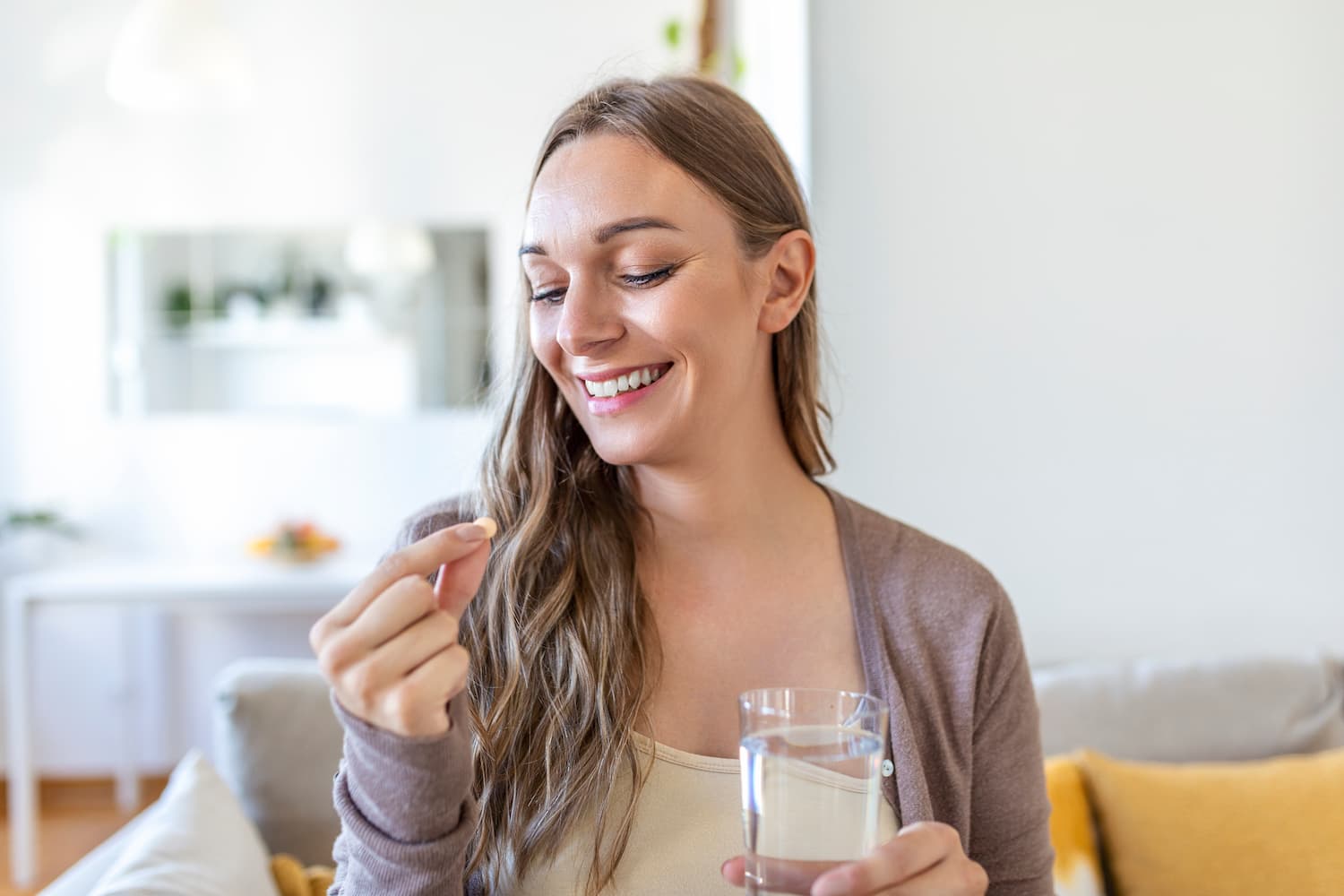
Glutathione is one of the most potent antioxidants for supporting the body's health. Find out how it works and where to get it from.

See why hip joints hurt and how to treat their ailments.

